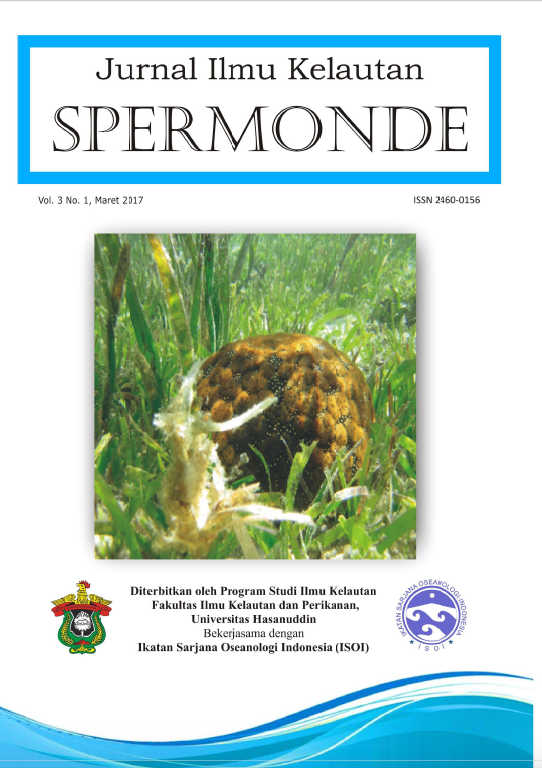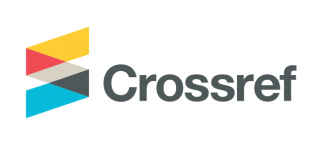POTENSI ABALON TROPIS Haliotis asinina L. SEBAGAI SUMBER INOKULUM JAMUR SIMBION PENGHASIL ANTIMIKROBA
DOI:
https://doi.org/10.20956/jiks.v3i1.2124Abstract
The research about “The Potencial of Tropical Abalone Haliotis asinina L. As Source of Mushroom Antimicroba Producing
Symbionts” had been done. This research aimed to know the abalone potency as a source of inoculum and to characterize
isolate fungal symbionts H. asinina L. Isolation of fungi symbionts H. asinina L. was performed used a PDA medium (Potato
Dextrose Agar). Characterization of isolates fungal symbiont from H. asinina L. consists of macroscopic and microscopic
observations, and activity testing against pathogenic bacteria and fungi. The results showed that there were isolates of fungal
symbionts H. asinina L. (Abl.J.1, Abl.J.2, and Abl.J.3). The results of macroscopic observation colony indicated Abl.J.1 and
Abl.J.3 isolate had a surface likes flour and Abl.J.2 isolate had a flat surface such as cotton; Abl.J.1 isolate green, Abl.J.2 isolate
light green and Abl.J.3 isolate black in colours. Three isolates had concentric circles; isolates Abl.J.1 and Abl.J.3 had radial
lines and isolate Abl.J.2 had not radial line. The result of microscopic observation showed that three isolates had not septa,
and hyaline (colorless); three isolates had asexual spores conidioshpore and all isolates was suspected to belong to the genus
Aspergillus. All isolates were able to inhibit the growth of Salmonella thypi bacteria and Candida albicans fungus and the
resulting compounds were bacteriocidal and fungicidal.
Keyword: Gastropods, H. asinina L., Symbiont fungus, Antimicrobal, Aspergillus.
References
Balcázar, J. L., I. B Ruiz-Zarzuela, D. Cunningham, D.
Vendrell, and J.L. Múzquiz. 2006. The role of
probiotics in aquaculture. Veterinary Microbiol.
: 173-186.
Barnet, H. L and B. B. Hunter. 2000. Illustrated
Genera of Imperfect Fungi. Burgess Publishing
Company. USA. 241 pp.
Blunt, J. W., B. R. Copp, M. H. G. Munro, P. T.
Northcote, and M. R. Prinsep. 2006. Marine
natural products. Natural Product Reports,
:26–78.
Bugni T. S, and C. M, Ireland. 2004. Marine-derived
fungi: A Chemically and Biologically Diverse
Group of Microorganisms. Nat. Prod. Rep.,
:143-63.
Burgessa, J. G., K. G. Boyda, E. Amstronga, Z. Jianga,
L. Yana, M. Berggrenb, U. Mayb, T. Pisacanec,
A. K. Granmob, and D. R. Adamsd. 2003. The
Development of a Marine Natural Product-based
Antifouling Paint. Biofouling, 2003. 19:197-
Campbell, N. A., B. R. Jane, and G. M. Lawrence.
Biologi. Edisi kelima Jilid III. Erlangga.
Jakarta. 436 hal.
Cappucino, J. G. and S. Natalia. 2001. Microbiology:
A Laboratory Manual, 6th Edition. Sinaeur
Associates, Inc. Sunderland.
Dwidjoseputro, 1998. Dasar-Dasar Mikrobiologi.
Djambatan. Jakarta. 214 hlm.
Gandjar, I., R. A. Samson, A. Oetari, dan I. Santoso.,
Pengenalan Kapang Tropik Umum.
Yayasan Obor Indonesia. Jakarta.136 hlm.
Geiger, D. L, 2005. Molecular Phylogeni and The
Geograpic Orogin of Haliotidae Traced by
Haemocyanin Sequences, Journal of Molluscan
Studies Advance. Santa Barbara Museum of
Natural History. pp. 1-6.
Harvell C. D., C. E. Mitchell, J. R. Ward, S. Altizer, A.
P. Dobson, R. S. Ostfeld, M. D. Samuel. 2002.
Climate warming and disease risks for terrestrial
and marine biota. Science 296: 2158–2162.
Johanne E, M. Litaay, Syahribulan. 2016. The bioactivity
of hexadecanoic acid compound isolated from
hydroid Aglaophenia cupressina lamoureoux
as antibacterial agent against salmonella typhi.
International J. Biological Medical Research Vol
No.2.
Noverita, D. F. dan S. Ernawati. 2009. Isolasi dan Uji
Aktivitas Antibakteri Jamur Endofit dari Daun
dan Rimpang Zingiber ottensii Val. Jurnal
Farmasi Indonesia Vol. 4 No. 4 : 171-176.
Universitas Nasional. Jakarta Selatan.
Pankey, G.A. and L.D. Sabath. 2004. Clinical relevance
of bacteriostatic versus bactericidal mechanisms
of action in the treatment of Gram-positive
bacterial infection. Oxford Journal 38: 864--870.
Molinski, T.F, D.S Dalisay, S.L Lievens, J.P.Saludes.
Drug development from marine natural
products. Nature Review Drug Discovery 8:69–
Nurfadillah, A., M. Litaay, R.B.Gobel, N. Haedar.
Potensi tunikata Polycarpa aurata sebagai
sumber inokulum jamur endosimbion penghasil
antimikroba. J. Alam dan Lingkungan 6 (12):
-16.
Radjasa, O.K., Y.M. Vaske, G. Navarro, H.C. Vervoort,
K.Tenney, R.G. Linington, P. Crews. 2011.
Highlights of marine invertebrate-derived
biosynthetic products: Their biomedical
potential and possible production by microbial
associants Bioorganic & Medicinal Chemistry
: 6658–6674
Rasyid, A. 2008. Biota Laut Sebagai Sumber Obat-
Obatan. Oseana, Vol : XXXIII No. 1, Hal : 12.
Pusat Penelitian Oseanografi-LIPI. Jakarta.
Samson, R. A., E.S. Hoekstra and J.C. Frisvad.
Introduction to food and airborne fungi.
Centraalbureau Voor Schimmelcultures,
Utrecht: 383 hlm.
Singh I. P and S. B. Bharate. 2005. Anti-HIV Natural
Products. Journal Current Science. 89: 269-
Tahir E., M. Litaay, R.B. Gobel. Nur Haedar, D.
Priosambodo dan Syahribulan. 2016. Potensi
tunikata Rhopalaea sp. sebagai sumber
inokulum jamur simbion penghasil antimikroba.
J. Spermonde 2(2): 33-37.
Varoglu, M., T. H. Corbett, F. A. Valeriote and P.
Crews. 1997. Journal Org Chem. 62. 7078.
Downloads
Published
Issue
Section
License

This work is licensed under a Creative Commons Attribution 4.0 International License














